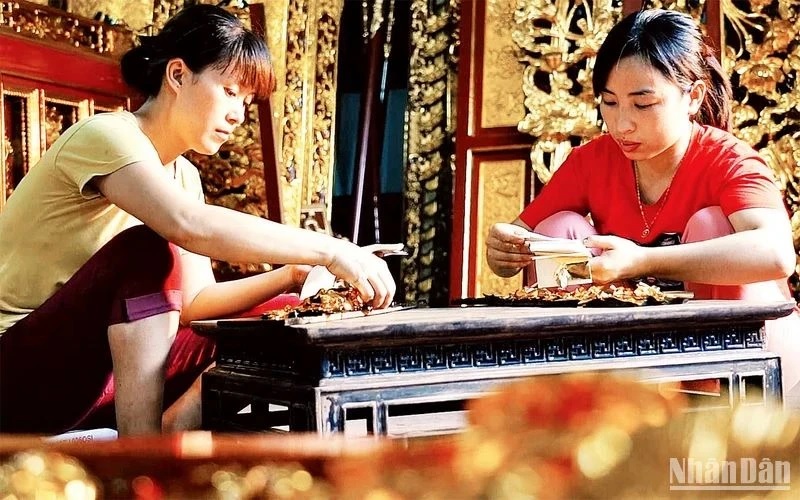In recent years, visitors to Vinh Long Province have been surprised by the ancient beauty of the "kingdom" of red ceramic bricks along the Thay Cai Canal and Co Chien River. During the 1980s, the province had nearly 3,000 brick kilns operating all year round, stretching nearly 30 kilometres, in Long Ho and Mang Thit Districts.

Artisans from Ha Thai Lacquer Craft Village in Thuong Tin District, Ha Noi, are creating handicraft products.
The local people have the technique of burning bricks in kilns with rice husk as material. Thousands of designs are produced by the talented hands of craftsmen, especially ceramic bricks with characteristic red from clay, creating unique features that cannot be found anywhere else. These products have been exported to foreign markets and are popular with consumers.
However, since 2010, when the technology was changed from circular kilns to continuous kilns to make the production process more environmentally friendly, brick kiln facilities have faced many difficulties due to high production costs and high selling prices of output products. As a result, their scale and operating capacity have been no longer as large as before. In just the past ten years, more than 1,000 brick kilns have been demolished, and the rest have been damaged or faced the risk of being dismantled.
To preserve and develop traditional ceramic brick craft in combination with tourism development, contributing to preserving the traditional cultural values of the community, Vinh Long Province has approved a specific support project for the conservation of brick and ceramic kilns for the entire heritage area of about 3,060 hectares, in four communes of My An, My Phuoc, Nhon Phu and Hoa Tinh of Mang Thit District. The project also aims to turn the “kingdom of red ceramics” into a destination on the region’s tourist map.
The project's goal is to promote the unique advantages of Vinh Long Province and the Mekong Delta region, such as typical culture and cuisine and the trade in the garden and floating ecological scenery. The ceramic brick craft village also demonstrates the spirit of hard work and creativity and is the enthusiasm of the next generation in preserving a traditional craft village on this land.
According to experts, a locality that follows the strategy of differentiating its tourism product must always strive to become “unique”, and must provide product attributes that make visitors believe that this product is only available at that locality. Therefore, the implementation of a different strategy is a long process with great effort.
"Mang Thit Contemporary Heritage" is one of the craft villages and distinct tourist highlights of the Mekong Delta region. This is the process of positioning products in the awareness of tourists, helping the tourism products of a province become unique and more competitive. Because of the specific values of tourism, in recent years, many provinces and cities in the region have begun to exploit and include traditional craft villages in tours and tourist routes.
Many craft villages have revived their values and created unforgettable impressions for tourists, such as Dinh Yen mat weaving village in Dong Thap Province, My Long rice paper village in Ben Tre, Tan Trung - Go Cong Dong altar making village in Tien Giang Province, and Thai Long fishing net weaving village in Can Tho Province, etc. The attraction of the craft villages is the idyllic and rural landscapes associated with people who love their crafts and artisans with skilful hands.
According to the Master Plan for the socio-economic development of the Mekong Delta key economic region by 2020, with a vision to 2030, the development of competitive tourism products contributes to affirming the tourism brand of the region based on maximising the advantages of natural conditions and cultural characteristics. This is in line with the spirit of Politburo’s Resolution No.08-NQ/TW (January 16, 2017) on developing tourism into a key economic sector. The resolution demonstrates the policy of sustainable development based on preserving and promoting the fine cultural heritage values of the nation.
Heritage is a treasure given by nature or the crystallisation of creative labour that the ancestors have painstakingly created from generation to generation. It is also a valuable resource that creates the unique brand and image of each locality and region.
Restoring, using and promoting the value of "ruins" properly will preserve traditional culture while creating attraction and leverage for tourism and economic development and livelihoods for people.
Ba Dung - Translated by NDO